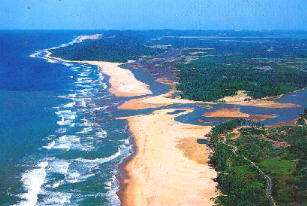Aquatic biomonitoring
.jpg)
Aquatic biomonitoring is the science of inferring the ecological condition of rivers, lakes, streams, and wetlands by examining the organisms that live there. While aquatic biomonitoring is the most common form of such biomonitoring, any ecosystem can be studied in this manner.
Biomonitoring typically takes different approaches:
- Bioassays, where test organisms are exposed to an environment to see if mutations or deaths occur. Typical organisms used in bioassays are fish, water fleas (Daphnia), and frogs.
- Community assessments, also called biosurveys, where an entire community of organisms is sampled, to see what types of taxa remain. In aquatic ecosystems, these assessments often focus on invertebrates, algae, macrophytes (aquatic plants), fish, or amphibians.[1] Rarely, other large vertebrates (reptiles, birds, and mammals) are considered as well.
- Online biomonitoring devices, using the ability of animals to permanently taste their environment. Different types of animals are used for that purpose either under lab or field conditions. The use of valve opening/closing activity of clams is one of the possible ways to monitor in-situ the quality of freshwater and coastal waters.[2]
Aquatic invertebrates have the longest history of use in biomonitoring programs.[3] In typical unpolluted temperate streams of Europe and North America, certain insect taxa predominate. Mayflies (Ephemeroptera), caddisflies (Trichoptera), and stoneflies (Plecoptera) are the most common insects in these undisturbed streams. In rivers disturbed by urbanization, agriculture, forestry, and other perturbations, flies (Diptera), and especially midges (family Chironomidae) predominate. Aquatic invertebrates are responsive to climate change.[4][5]
See also
- Bioindicator
- Biological integrity
- Biological monitoring working party (a measurement procedure)
- Indicator species
- Water pollution
References
- ↑ Karr, James R. (1981). "Assessment of biotic integrity using fish communities". Fisheries. 6: 21–27. doi:10.1577/1548-8446(1981)006<0021:AOBIUF>2.0.CO;2. ISSN 1548-8446.
- ↑ "MolluScan Eye". Environnements et Paléoenvironnements Océaniques et Continentaux. Talence, France: Université de Bordeaux. Retrieved 2016-08-04.
- ↑ Barbour, M.T.; Gerritsen, J.; Snyder, B.D.; Stribling, J.B. (1999). Rapid Bioassessment Protocols for Use in Streams and Wadeable Rivers: Periphyton, Benthic Macroinvertebrates and Fish (Report) (2nd ed.). Washington, D.C.: U.S. Environmental Protection Agency (EPA); Office of Water. EPA 841-B-99-002.
- ↑ Lawrence, J.E., K.B. Lunde, R.D. Mazor, L.A. Bêche, E.P. McElravy, and V.H. Resh. 2010. "Long-Term Macroinvertebrate Responses to Climate Change: Implications for Biological Assessment in Mediterranean-Climate Streams." Journal of the North American Benthological Society 29: 1424-1440.
- ↑ Filipe, A.F.; J.E. Lawrence; N. Bonada (November 2013). "Vulnerability of Biota in Mediterranean Streams to Climate Change: A Synthesis of Ecological Responses and Conservation Challenges". Hydrobiologia. 719: 331–251. doi:10.1007/s10750-012-1244-4. Retrieved 10 November 2013.
- Rosenberg, David M.; Resh, Vincent H., eds. (1993). Freshwater Biomonitoring and Benthic Macroinvertebrates. New York: Chapman and Hall. ISBN 0412022516.

